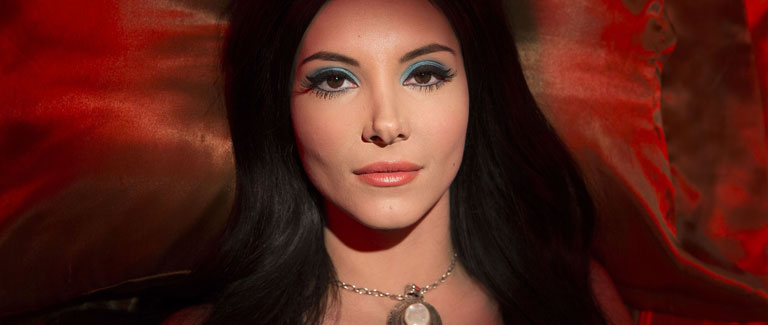Screening as a double feature in conjunction with the Museum of Sex’s exhibition, "NSFW: The Female Gaze," Anna Biller’s films Viva and The Love Witch both take on the notion of female subjectivity, though in very different ways. In Viva, Biller exposes the dark side of the sexual revolution through the dangers its main character experiences. In The Love Witch, the film’s title character, also known as Elaine, searches for a perfect love by stroking up desire through potions and spells, only to meet a violent fallout. Both presented on 35mm, the films are a treat to behold on their own, and even more so when put into conversation with one another. Biller’s dedication to crafting an entire filmic universe for her characters—from the lighting to the procurement and placement of props—aids in filling out female narratives that are often left untold.
To mark the occasion, we spoke with Anna Biller about her films, the female gaze, and desire.
This interview has been edited and condensed for clarity.
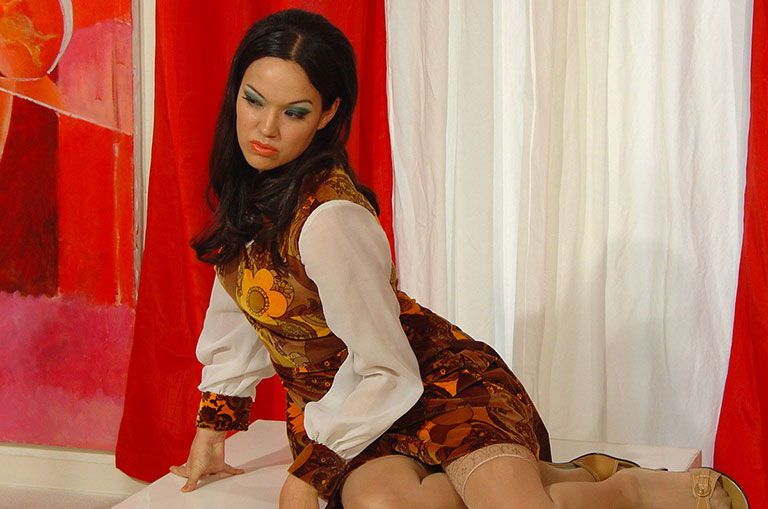
Anna Biller in Viva
Brittany Stigler: These films are screening as part of the Museum of Sex’s exhibition “NSFW: The Female Gaze,” so I just wanted to start off by asking you: what do you like to look at and what kind of films you find pleasurable to view?
Anna Biller: I mostly watch classic movies, and what I enjoy about the classic movies is, first of all, is that they’re so beautiful in terms of pure cinema. You know the sensuality of them, the lighting, the costumes, the makeup, the glamour. And also the fact that they had very good roles for women that were well written. Women were strong and funny and smart, and they were often subjects of the film, instead of just side characters. They’re just pleasurable for me in every way.
How do you translate that sort visual pleasure that you experience from the classic movies into your own films?
One thing I do is I study the classic movies for all of those sensual things that I love in them—especially things like lighting and color. Costume and makeup. And one thing I really also love about those movies is how much interior decoration there was that was so good. So I study the interior decoration. And I see movies as kind of a complete sensual experience. We’re voyeurs when we go into a movie theater; it’s dark, and you’re having a personal experience with the images on the screen, and it’s a freudian erotic experience. I love it when objects are treated erotically. You know, when a glass has a beautiful sparkle on it. Or when just the color and the frame is treated in a special way. I think that’s what creates art. It’s not a replication of life. What creates cinema is putting a point of view on it.
I know that nowadays the trend is to have a point of view be that what people consider more real or more raw is when films look like they’re not lit, and it’s as if they are translating something directly from themselves right into the movie, and they feel that is going to be the most real. But in my experience that’s not true. I think the way to create something real is to figure out how to translate your subjectivity into art in a certain way. And I think all the other arts do that. Painting, sculpture, music. All the other arts are about translating a kind of subjectivity into form. And somehow film has lost that. That sense of wanting to create subjectivity through form.
Take lighting for example. Let’s say see you someone and you find that person really, really exciting. When you look at that person, your eye is going to go to that person, and you’re going to focus on that person in a special way, and they’re going to appear to be brighter than anyone around them—like a halo effect. That’s what lighting used to do in classic movies. They used to separate out things with framing and lighting so that you’d experience those things with a kind of intense subjectivity. It wouldn’t be specially considered if it wasn’t supposed to be important, and if things were lit in a certain way. If there were close ups of them, then you would know that they were more important to characters that were looking at them. So that’s how you develop the film language. You cue the viewers into the subjectivity of the characters and the subjectivity of the filmmaker by how you lit and filmed and edited.
But that’s no longer the case in filmmaking. You know, people try to do almost everything like in a documentary style so there is no subjectivity, and they allow the viewer to insert their own subjectivity. And that’s one kind of filmmaking, and what has surprised me is that it has become the only kind of filmmaking. It’s one option, and it’s an interesting option, but it’s not the only option.
So, if you’re talking about a female gaze and female desire and pleasure, for me: I love color, I love interior decorating, I love objects, I love faces. And so for me a female gaze is about gazing at the things that I find interesting. And maybe for a man, you know when you’re trying to create desire on the screen, one of the most powerful images for a man on the screen is a naked woman. And for me it’s not. It’s a lot of other things that are just as interesting or more interesting than a naked women, and that’s how I make my films. So you see that there might be nudity in my films, but the nudity isn’t treated differently than everything else.
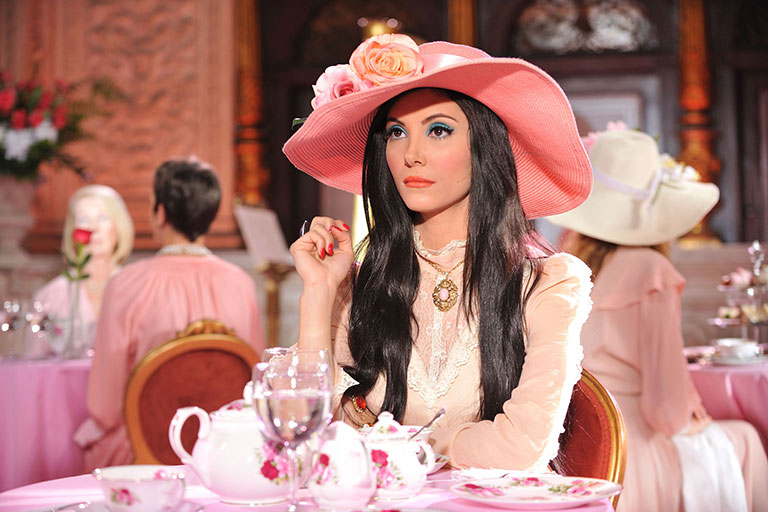
Samantha Robinson in The Love Witch
For me personally, I know when I was looking at Elaine, I really didn’t desire her in a physical way, but just the way everything was put together on her and the way she interacted with the world was very desirable. It was just a very tactile experience, and I was wondering, how do you go about that?
It’s interesting because I do think about, what do I want to see. What is my fantasy? What do I want to see on the screen? And I try to be honest with myself. So I create pink tea room, and I think, OK, I designed this set, this pink tea room, so what should the women wear in this tea room? And I start doing the costumes, and I found all these pink and peach dresses at a thrift store, which was a huge windfall for me, because I didn't have to make a lot of the background costumes. Do I want to go that far, do I want to put people in big flower hats? Do I want to go there, and I think, yes, I do want to go there. Do I want Elaine to be in a big flowered hat? Do I, do I not; I didn’t decide until last minute. Ok, I have a hat for her, we’ll put it on, we’ll see how it looks. I love it, I love the hat on her. So I keep thinking what I’d like to see. And I start buying tea sets, and it’s like I want all of the tea sets to be these perfect, cute, adorable tea sets. And what do I want on the table? Well, it’s high tea. I keep working on it until it feels like it’s right, and I guess when I feel it’s right, it’s more over the top than what other people would put in a movie.
But I think it’s because so much of the time, the objects in the sets are afterthoughts. People hire a prop master the last minute, and they don’t have enough time and scramble things together at the last minute, and they’re not important. But for me, they’re characters in the movie, so I think women, or most women, have a fantasy about a perfect world they can live in. Most people don’t think they go out in the world and think they look perfect. That they have the perfect outfit. That they have the perfect accessories. Sometimes we all want that. We all want to fantasize about living in this kind of world of aesthetic pleasure. So I like to create that in a movie sometimes. I think it’s fun, I think it’s nice. But not to make it fake or silly. But to kind of contrast that with the interior world of a woman that’s really untidy.
How manicured Elaine’s life is really makes her realization that her life isn’t perfect, and that she can’t make it perfect with witchcraft, all the more devastating. There is so much pleasure in the movie, but in the back half of the movie, there is a ton of fear. What’s the role of fear and how does it contrast or even work in tandem with pleasure and love?
I felt it was really important to have the character experience a lot of fear and terror in that scene where she’s attacked in the bar, but also in the scene where she has kind of a sexual encounter that’s pretty unwanted. You know in the coven, where she’s terrified of it. It’s something she’s probably consented to, and she’s regretting it, but she doesn’t pull out. It’s like, I just want to show reality. So again, we’re talking about styles of filmmaking earlier and how people want to show what things are really like, and I want to show how things are really like, too. and I feel like being a woman is an experience of fear: you’re afraid of men, you’re afraid of rapists. You’re afraid of being attacked, you’re afraid of speaking up, and you’re afraid of having a voice.
And I just don’t really know if that is examined much in movies. This idea that even a woman that seems so strong, she seems so together, she’s still a woman, and she lives in a world with men and predators. And a world in which people are always trying to silence her. And I just want to kind of create a feeling of reality in her world. So she does try to create her own desire and her own pleasure and she tries to make her world perfect around her, but she lives in a society. That scene in that bar, where the men all attacked her. That’s not that far-fetched. Those things happen to women all the time.
I guess that fear is something that I wanted to explore and express. Because all you have to do is be a woman that men either feel attracted to or feel threatened by. The idea was that those men turn on her and they want to rape her not out of sexual desire but hatred. They hate her because she thinks she’s a witch. I think rape is a form of control, not a form of desire. It’s a form of violence and a form of control. And I like show how it’s the men in their hatred and their fear of her that want to rape her. It is nothing to do with desire. Her raw palpable fear there. I don’t want to show a movie where a woman is killing men or ostensibly causing men’s death and make it feel like that’s really the reality—that’s the balance of power in the world; that women are the destroyers—but to show it in context of the real world. And the dynamics of the real world are really more like that bar. I felt like I had to include that to show that this is the actual context that we live in. It’s not a fantasy world where women control anything.
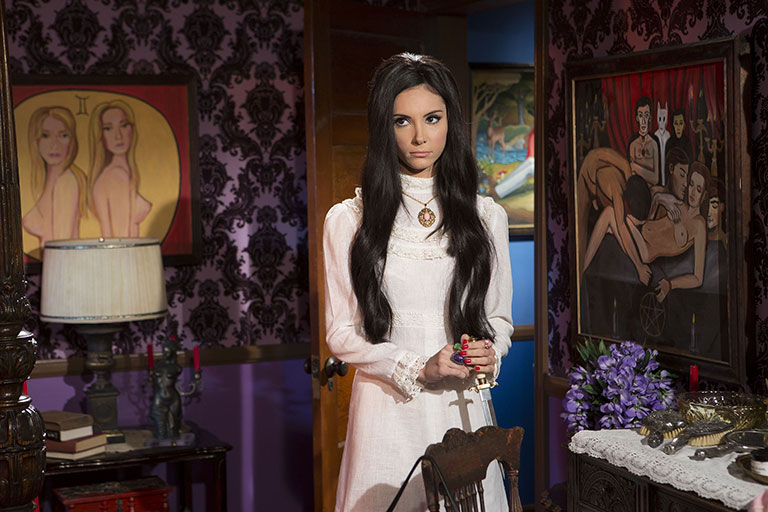
Samantha Robinson in The Love Witch
Thinking about the opposite of that, something going on in cultural right now is that people are really grasping to the idea of the coven and the sisterhood and witchcraft, and I wanted to talk to you about friendship and sisterhood in your movies and what role they play:
I’ve noticed what you’ve talking about as well, there’s a new type of solidarity among women, and I have to tell you that didn’t feel like that was happening when I was younger, so I think that’s pretty exciting. And I think when I was younger, especially a teenager and in my early twenties, I really felt that women didn’t feel safe just bonding with other women. There was a sense in which if you wanted to make it in the world you had to attach yourself to men. And I feel that that’s changing. I think that’s quite amazing. And I think it’s because it’s more women are in positions to help other women. So you don’t actually have to have a male partner or a male business partner or anything to rise in the world. You can actually help women help each other.
But when I made Viva, I wasn’t experiencing that shift yet. The friendships in the two movies are a little bit different, because I feel that the friendship in Viva was a little bit about how Sheila had white privilege and Barbi didn’t. And so their relationship was strained by that. So because Sheila had white privilege, she knew a lot of things from her upbringing and being part of a culture that Barbi didn’t know. And I feel that a lot of Barbi’s experiences of trauma had to do with the fact she was an outsider. And it’s never explicitly mentioned in the script that she’s the only person of color in white suburbia, but I think it’s implicit. So, I think that it was like their friendship was marred by that difference. They were still able to be friends but Sheila had a certain callousness about her because of not understanding the difference between her and Barbi. And she was the one that drew Barbi into this really dangerous world and then she herself didn’t become scathed by the world. So Sheila wasn’t the best fiend in the world.
But it isn’t like I wouldn’t imagine that there couldn’t be a utopian friendship between women. I also think that Trish would have been a great friend, was a great friend, and she was betrayed by Elaine, because Elaine was a flawed character. Elaine was back in the old mentality of having to use men to rise in the world, and only men have the power, and she didn’t really trust in female friendships. But she had more of a real friendship with Barbara, but Barbara, the high priestess, but the high priestess also was kind of in a weird relationship with her own husband, where her husband is doing sexual initiations with other women right in front of her and she just doesn’t mind. And she’s smiling, even if those other women are hurt by it, and I think that’s sort of messed up.
I guess in my movies, there’s a sense of women living in this sort of ghetto, where they keep trying to get out of it, but they can’t really get out of it. So, the women are fabulous, and they’re trying to be empowered, and they’re trying to make the right choices, but it’s hard to have a real friendship if there are all of these social forces opposing that.
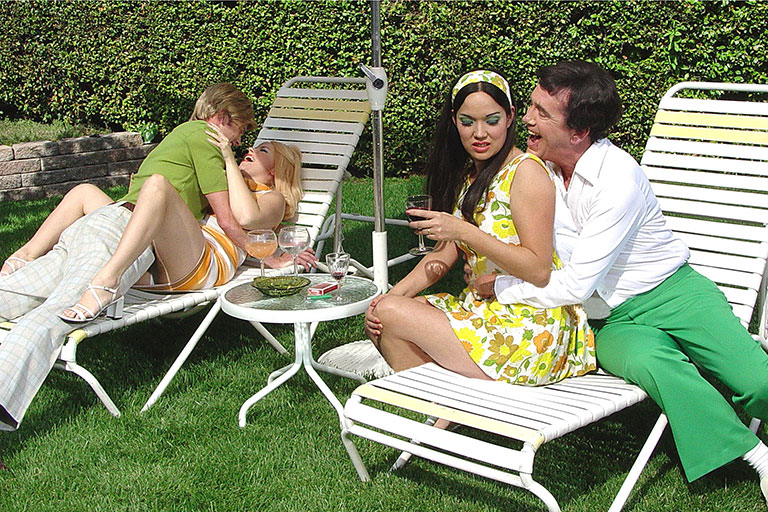
Chad England, Bridget Brno, Jared Sanford, and Anna Biller in Viva
It’s very sad.
It’s sad, right? But it’s not some sort of outlandish, dark world I’m painting that isn’t reality.
No, your film has felt the most real to me of any film that I’ve watched in such a long time, and I think a lot of different people feel that way.
It’s interesting because I think for a lot of women, it feels very real. But you’ll see the reviews and comments from a lot of men, who are like: this film’s about nothing, this film is so boring, it has no subject matter, it’s all it is is pretty visual design. Like, wow, the author should really have a less muddled message, she doesn’t know what she’s talking about. So women’s lives have no content, and there’s no such thing as a women’s subjectivity, and a film that a female filmmaker makes is stupid.
It’s sad, right? It’s depressing.
It is, and it just makes me wonder about you: I get the sense that there is a certain kind of reduction of the female filmmaker to just a female filmmaker, and not kind of including her in a broader term. And obviously you star in Viva , and as for The Love Witch , I can’t see how anyone could separate you from that film. Do you feel objectification from that or as a female a filmmaker?
Very much with Viva, I felt objectified because men were commenting on my body. And when I would go to film festivals, they would try to get me to pose in sexy ways and lay down on the floor and take all these pictures. And I was much more passive back then, I was kind of like the character. It’s so funny, because the character in Viva is very passive, and she lets herself get photographed, and she does whatever she’s told. And so I went out to this film festival, and I was actually doing the same thing. Photographers kept asking me to pose and do this and do that, and I would just do it. After a while, I started to become kind of upset by it. I made a movie where I was complaining about women being treated like this, and now because I made that movie, I’m now been treated like this, and I hadn’t been treated like that since I was much younger, in college or something, and now it’s like OK. It’s really, really strange. So I became very upset by that actually. And it ruined acting for me. I wouldn’t have acted in the next film anyway, but it sort of ruined acting for me. I just never wanted to be in front of a camera anymore at all, not even to be photographed. I still feel that way, because the level of objectification was so outrageous. And now I feel that they’re objectifying my star [of The Love Witch] in a way that feels personal to me.
But I don’t feel ghettoized in the sense of being called a female filmmaker, because I think that because there still aren’t that many female filmmakers, it feels more like a boost. You can have articles written, and you’re included in lists and things, I think it just wouldn’t be as much press. It’s just a way of giving people a boost that otherwise maybe would have been just ignored. But there isn’t really a common thread necessarily between films women make, but there are certain films made by certain women that definitely could have only been made by women, that they’re very, very subjective in terms of female experience. I think that it’s interesting to highlight and showcase those films and talk about how they’re different and what that difference says, and have a discussion about it, and I think that I like to do that. I like to kind of look at other work by female directors and try to find common themes.
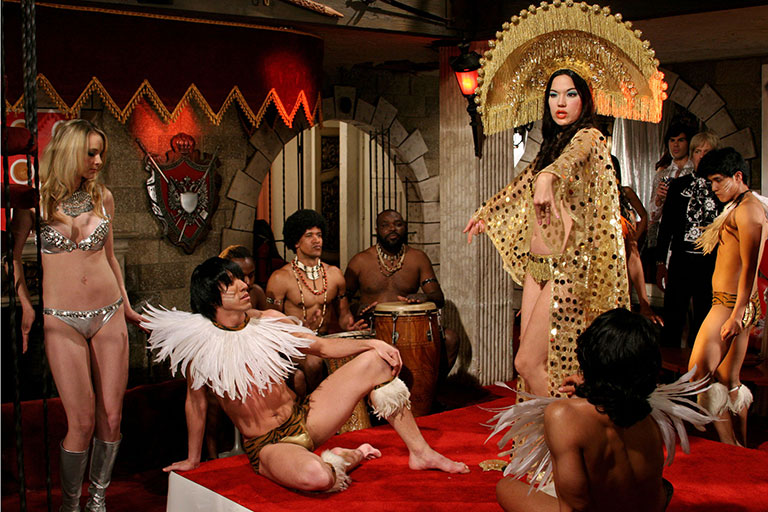 Anna Biller in Viva
Anna Biller in Viva
So you see it as being more useful than anything?
I like it for now. I haven’t really seen anything negative about it so far. Because in the real world, in terms of people selecting your films for festivals or giving you funding for a movie, the playing field is still not level. It’s still not level, so I think we need all the help that we can get.
In terms of touring The Love Witch , is it hard to find theaters to play the 35mm version?
Not really, because the kinds of theaters that would want my film, a lot of them still project 35. In fact a lot of theaters really wanted 35 and couldn’t get it because they only made four prints. So it was only select theaters that could screen the 35. Now that the theatrical run is over, those prints are just sitting around, so if anyone wants to program them on 35mm it’s available.
I wonder, are more filmmakers going back to film?
I think people understand the beauty of film. And when you’re making a professional film, it’s actually really not much more expensive, but that’s something people don’t really understand. Because when you have to do a professional color toning process, the machines and technicians are extremely expensive. The color toning in post is so much cheaper on film in that sense. The camera’s also much cheaper. So the only thing that is more expensive is stock, and the processing. But if you don’t go crazy and shoot a lot of footage, I think it pretty much evens out on a professional movie. If your budget is at least a million dollars, the cost is pretty negligible.
I’m assuming on your next project you’ll probably shoot on film, right?
Absolutely. Unless overnight the whole system collapses and Kodak announces it’s not making film anymore, then yeah I’ll be shooting on film as long as I can.
